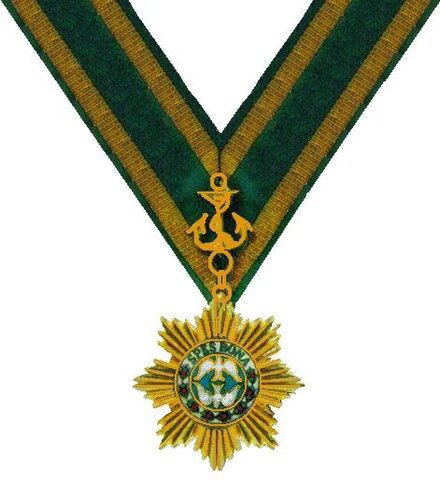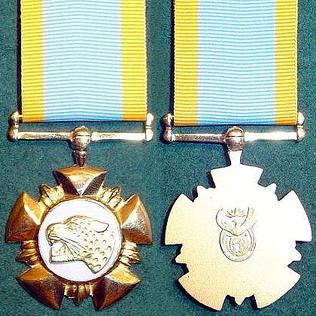
The Nkwe ya Gauta - Golden Leopard, post-nominal letters NG, is a military decoration for bravery which was instituted in 2003, to replace the Honoris Crux Gold (HCG). It is South Africa's highest military decoration for bravery.

The Nkwe ya Selefera - Silver Leopard, post-nominal letters NS, was instituted by the President of the Republic of South Africa on 16 April 2003 and came into effect on 27 April 2003. It is South Africa's second highest military decoration for bravery.

The Nkwe ya Boronse - Bronze Leopard, post-nominal letters NB, is a military decoration for bravery which was instituted in 2003. It is South Africa's third highest military decoration for bravery.
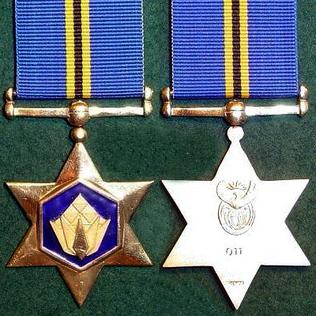
The iPhrothiya yeGolide - Golden Protea, post-nominal letters PG, was instituted by the President of the Republic of South Africa on 16 April 2003 and came into effect on 27 April 2003. It can be awarded to all ranks who have distinguished themselves by exceptional leadership or exceptional meritorious service and the utmost devotion to duty. It is South Africa's highest existing military decoration for meritorious conduct.

The iPhrothiya yeBhronzi - Bronze Protea, post-nominal letters PB, was instituted by the President of the Republic of South Africa on 16 April 2003 and came into effect on 27 April 2003. It can be awarded to all ranks who have distinguished themselves by leadership or meritorious service and devotion to duty.
An overview of South African military decorations and medals, which form part of the South African honours system.
The South African honours system consists of orders, decorations, and medals which are conferred on citizens, and others, to recognise a range of services and achievements. The system has developed since 1894.

The Honoris Crux Gold, post-nominal letters HCG, is a South African military decoration for bravery which was instituted in 1975. It was awarded to members of the South African Defence Force for outstanding acts of bravery while in extreme danger. It was the second most senior in a set of four classes of Honoris Crux decorations which replaced the discontinued Honoris Crux of 1952.
The Republic of Namibia has an honours system comprising orders, medals, military decorations, and police decorations. Legislation also provides for the establishment of decorations and medals for the intelligence service, the prisons service, and the fire services.

The Star of South Africa, Gold, post-nominal letters SSA, is the senior decoration of two military and five non-military classes of the Order of the Star of South Africa, a South African Order which was instituted in 1975, for award to general and flag officers of the South African Defence Force. The Order of the Star of South Africa was discontinued in 2002.

The Star of South Africa, Silver, post-nominal letters SSAS, was the second level decoration of two military and five non-military classes of the Order of the Star of South Africa, which was instituted by the Republic of South Africa on 1 July 1975. It was awarded to general and flag officers of the South African Defence Force for exceptionally meritorious service of major military significance. The Order of the Star of South Africa was discontinued in 2002.

The Star of South Africa, Grand Cross, post-nominal letters SSA, is the senior decoration of five non-military classes of the Order of the Star of South Africa, a South African Military Order that was instituted by the Republic on 1 July 1975. The Order of the Star of South Africa was discontinued in 2002.

The Star for Bravery in Gold, post-nominal letters SBG, was instituted by the President of the Republic of South Africa in April 1996. It was awarded to veteran cadres of Umkhonto we Sizwe, the military wing of the African National Congress, who have distinguished themselves during the "struggle" by performing acts of exceptional bravery in great danger.
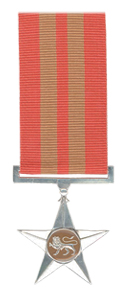
The Star for Bravery in Silver, post-nominal letters SBS, was instituted by the President of the Republic of South Africa in April 1996. It was awarded to veteran cadres of Umkhonto we Sizwe, the military wing of the African National Congress, who had distinguished themselves during the "struggle" by performing acts of bravery.

The Merit Medal in Silver, post-nominal letters MMS, was instituted by the President of the Republic of South Africa in April 1996. It was awarded to veteran cadres of Umkhonto we Sizwe, the military wing of the African National Congress, who had distinguished themselves during the "struggle" by exceptionally meritorious service and particular devotion to duty.

The Silver Medal for Merit, post-nominal letters SMM, was instituted by the President of the Republic of South Africa in April 1996. It was awarded to veteran cadres of the Azanian People's Liberation Army, the military wing of the Pan Africanist Congress, for exceptionally meritorious service and particular devotion to duty during the "struggle".

The Star of South Africa, Officer, post-nominal letters OSSA, is the fourth-ranked decoration of five non-military classes of the Order of the Star of South Africa, a South African military order that was instituted by the Republic on 1 July 1975. The Order of the Star of South Africa was discontinued in 2002.

The Woltemade Cross for Bravery, Gold, post-nominal letters WD, is the senior of two classes of a South African civil decoration for acts of bravery. It replaced the Union of South Africa King's Medal for Bravery, Gold, Union of South Africa Queen's Medal for Bravery, Gold and Woltemade Decoration for Bravery, Gold, all of which ranked on par with each other and the award of which had been discontinued in 1952, 1961 and 1988 respectively.
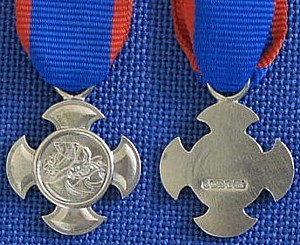
The Woltemade Cross for Bravery, Silver, post-nominal letters WDS, is the lesser of two classes of a South African civil decoration for acts of bravery. It replaced the Union of South Africa King's Medal for Bravery, Silver, Union of South Africa Queen's Medal for Bravery, Silver and Woltemade Decoration for Bravery, Silver, all of which ranked on par with each other and the award of which had been discontinued in 1952, 1961 and 1988 respectively.
The Star of South Africa, Grand Officer, post-nominal letters SSAS, is the second decoration of five non-military classes of the Order of the Star of South Africa, a military order that was instituted by the Republic of South Africa on 1 July 1975. The Order of the Star of South Africa was discontinued in 2002.
Alexander, E. G. M., Barron G. K. B. and Bateman, A. J. (1986). South African Orders, Decorations and Medals. Human and Rousseau.
Monick, S. (1990). South African Civil Awards 1910–1990. South African National Museum of Military History.

